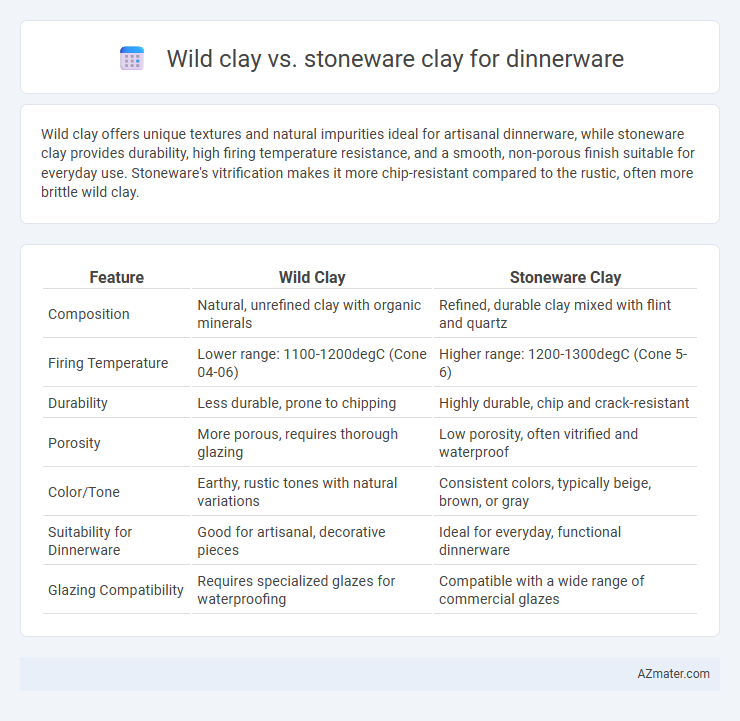Wild clay offers unique textures and natural impurities ideal for artisanal dinnerware, while stoneware clay provides durability, high firing temperature resistance, and a smooth, non-porous finish suitable for everyday use. Stoneware's vitrification makes it more chip-resistant compared to the rustic, often more brittle wild clay.
Table of Comparison
| Feature | Wild Clay | Stoneware Clay |
|---|---|---|
| Composition | Natural, unrefined clay with organic minerals | Refined, durable clay mixed with flint and quartz |
| Firing Temperature | Lower range: 1100-1200degC (Cone 04-06) | Higher range: 1200-1300degC (Cone 5-6) |
| Durability | Less durable, prone to chipping | Highly durable, chip and crack-resistant |
| Porosity | More porous, requires thorough glazing | Low porosity, often vitrified and waterproof |
| Color/Tone | Earthy, rustic tones with natural variations | Consistent colors, typically beige, brown, or gray |
| Suitability for Dinnerware | Good for artisanal, decorative pieces | Ideal for everyday, functional dinnerware |
| Glazing Compatibility | Requires specialized glazes for waterproofing | Compatible with a wide range of commercial glazes |
Introduction to Wild Clay and Stoneware Clay
Wild clay, also known as natural or raw clay, is harvested directly from the earth and contains a variety of minerals and organic materials that give it unique textures and colors. Stoneware clay is a dense, non-porous material fired at high temperatures, typically between 1,200degC and 1,300degC, resulting in durable, chip-resistant dinnerware. Both clays are popular for dinnerware, with wild clay offering rustic aesthetics and stoneware providing strength and functionality for everyday use.
What is Wild Clay?
Wild clay, also known as natural or raw clay, is sourced directly from the earth with minimal processing, preserving its unique mineral composition and organic impurities. This clay offers a rustic aesthetic and varies in color and texture, providing a distinct, natural look for dinnerware. In contrast, stoneware clay is a refined, high-fire clay known for its durability, strength, and vitrification, making it more suitable for everyday use and functional dinnerware items.
What is Stoneware Clay?
Stoneware clay is a durable, non-porous ceramic material fired at temperatures between 1,200degC and 1,300degC, making it ideal for functional dinnerware due to its strength and resistance to chipping. This clay matures into a vitrified, glass-like state that ensures food safety and ease of cleaning. Compared to wild clay, stoneware offers consistent texture and color, enhancing the aesthetic appeal and longevity of dinnerware pieces.
Sourcing and Processing: Wild Clay vs Stoneware
Wild clay is typically sourced locally from natural deposits, often requiring minimal processing such as sieving and wedging to remove impurities and achieve the desired texture. Stoneware clay, mined from specific geological formations, undergoes extensive processing including refining, aging, and blending to ensure consistent quality and optimal firing properties. The natural variability in wild clay can affect durability and finish, while stoneware's processed consistency supports reliable, high-temperature firing ideal for durable dinnerware.
Workability and Forming Differences
Wild clay, often derived from natural deposits, contains a mix of minerals and organic materials that influence its plasticity and workability, making it less consistent but highly textured for dinnerware. Stoneware clay, known for its refined particles and higher firing temperature, offers superior plasticity and durability, allowing smoother forming techniques such as throwing or hand-building with precise control over shape and surface. The natural variability in wild clay can create unique, rustic finishes, whereas stoneware provides standardized performance and strength essential for functional dinnerware.
Firing Temperatures and Techniques
Wild clay, typically sourced locally with variable mineral content, requires lower firing temperatures ranging from 1,800degF to 2,100degF, making it suitable for earthenware techniques that allow for porous and rustic dinnerware finishes. Stoneware clay, fired between 2,100degF and 2,300degF, undergoes vitrification during high-temperature firing that results in dense, durable, and non-porous dinnerware ideal for daily use. Techniques for wild clay often involve oxidation or pit firing for textured effects, while stoneware benefits from controlled kiln atmospheres like reduction firing to enhance strength and glaze maturity.
Durability and Strength for Dinnerware
Wild clay typically has a more natural composition with variable mineral content, which can result in moderate durability but less consistency in strength compared to stoneware. Stoneware clay is fired at higher temperatures, producing a dense, non-porous material that offers superior strength and excellent durability, making it ideal for everyday dinnerware. The vitrification process in stoneware ensures resistance to chipping, cracking, and thermal shock, outperforming wild clay in long-term functionality.
Food Safety and Toxicity Concerns
Wild clay often contains natural minerals and impurities that may pose food safety and toxicity concerns when used for dinnerware without proper testing and firing. Stoneware clay, fired at high temperatures around 1200-1300degC, creates a dense, vitreous surface that is non-porous and food-safe, minimizing leaching of harmful substances into food. Certified stoneware dinnerware adheres to strict safety standards, ensuring it is lead and cadmium-free, while wild clay pieces require thorough lab analysis to confirm food safety.
Aesthetic Qualities: Color, Texture, and Finish
Wild clay offers a rustic aesthetic with natural color variations ranging from earthy browns to subtle reds, creating unique, organic textures that highlight handcrafted imperfections. Stoneware clay provides a more uniform color palette, often in muted tones like greys, tans, and whites, with a smooth, dense texture that results in a refined, durable finish ideal for modern dinnerware. The finish of wild clay is typically matte or satin, enhancing its artisanal appeal, while stoneware clay can achieve both glossy and matte finishes, offering versatility in contemporary table settings.
Environmental Impact and Sustainability
Wild clay is often locally sourced and minimally processed, reducing transportation emissions and energy consumption compared to stoneware clay, which typically requires higher firing temperatures and extensive refinement. Stoneware clay's durability provides long-lasting dinnerware, but its production involves increased energy use and carbon footprint due to kiln firing at temperatures around 1200-1300degC. Sustainable dinnerware choice depends on prioritizing either lower immediate environmental impact from wild clay or the extended lifecycle benefits of resilient stoneware products.

Infographic: Wild clay vs Stoneware clay for Dinnerware
 azmater.com
azmater.com